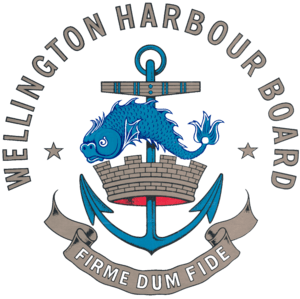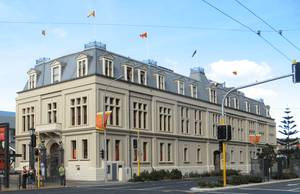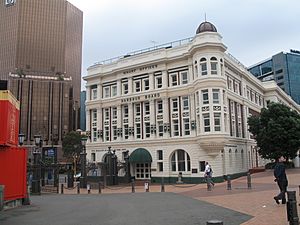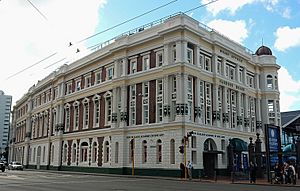Quick facts for kids
Wellington Harbour Board

Coat of arms of the Wellington Harbour Board
|
| Abbreviation |
WHB |
| Motto |
Latin: Fime dum fide
(Strong but true) |
| Formation |
January 1, 1880; 145 years ago (1880-01-01) |
| Dissolved |
October 31, 1989; 36 years ago (1989-10-31) |
| Purpose |
Port operator |
| Headquarters |
Wellington, New Zealand |

Head Office and Bond Store on Queens Wharf.

Wharf offices from the Government or Queen's Wharf.

The former wharf offices seen from Post Office Square.
The Wellington Harbour Board was a group set up by the New Zealand Parliament to manage the port of Wellington. It officially started on January 1, 1880. This board was made up of people chosen by different groups. These included shipowners, businesses that paid port fees, and representatives from areas like Wellington City, Hutt County, and Wairarapa County. The Mayor of Wellington was also a member, along with one person chosen by the government.
In October 1988, the way the port was run changed. The government decided that a regular business, called Port of Wellington Limited, should take over from the Board. This meant that the Board's plans to manage its waterfront land and become a company itself were no longer needed.
The government made new rules for how ports should be run in New Zealand. These rules were part of the Ports Reform Act of April 1988. Because of these changes, the Wellington Harbour Board eventually closed down. After selling its remaining properties, the money was shared among the local councils in the Wellington, Hutt, Wairarapa, and Manawatu areas. The Wellington Harbour Board officially ended on October 31, 1989, as part of bigger changes to local government.
How the Board Started
When the Wellington Harbour Board was first created, it had the power to charge fees for goods that passed through the port. However, it didn't own any land or buildings at the port. At that time, the Harbourmaster (the person in charge of the port) and the Pilots (who guide ships) were government workers. The Wellington City Council owned Queens Wharf and its storage building. There was also a new wharf and reclaimed land, but these belonged to New Zealand Railways.
Changing the Coastline: Land Reclamation
Main article: Reclamation of Wellington Harbour
The Wellington Harbour Board played a big part in changing the shape of Wellington's coastline. They did this by creating new land from the sea, a process called land reclamation. This helped the port grow and allowed for more space for ships and buildings.
-
Lambton Harbour, a key part of Wellington's port.
-
The Container Terminal, built on reclaimed land.
-
Reclaimed land for future port expansion, including the stadium area.
-
Tugs like Kupe, Ngahue, and Toia help guide ships in the harbour.
Leaders of the Wellington Harbour Board
The Wellington Harbour Board had many different leaders, called Chairmen, during its time. These individuals were responsible for guiding the Board's work and managing the port. Here is a list of the people who served as Chairman:
| No. |
Chairman
(Birth–Death) |
Portrait |
Term of office |
Constituency |
| 1 |
William Levin
(1845–1893) |
 |
1880 |
1881 |
Governor |
| 2 |
William Valentine Jackson
(1832–1900) |
 |
1881 |
1883 |
Wellington |
| 3 |
Edward Pearce
(1832–1922) |
 |
1883 |
1887 |
Governor |
| 4 |
John Duthie
(1841–1915) |
 |
1887 |
1888 |
Wellington |
| 5 |
Henry Rose
(1833–1912) |
 |
1888 |
1891 |
Shipowners |
| 6 |
William Booth
(1837–1903) |
 |
1891 |
1892 |
Wairarapa |
| 7 |
John Honeycombe Cock
(1848–1892) |
 |
1892 |
1893 |
Chamber of Commerce |
| 8 |
John Jack
(1827–1909) |
 |
1893 |
1895 |
Wellington |
| 9 |
Thomas John William Gale
(1853–1903) |
 |
1895 |
1897 |
Chamber of Commerce |
| 10 |
Francis Humphris Fraser
(1833–1911) |
 |
1897 |
1899 |
Governor |
| 11 |
John Hutcheson
(1854–1940) |
 |
1899 |
1900 |
Government |
| 12 |
Harold Beauchamp
(1858–1938) |
 |
1900 |
1903 |
Wellington |
| 13 |
Nicholas Reid
(1837–1915) |
 |
1903 |
1904 |
Shipowners |
| 14 |
William Cable
(1848–1922) |
 |
1904 |
1906 |
Wellington |
| 15 |
Kennedy Macdonald
(1847–1914) |
 |
1906 |
1908 |
Governor |
| 16 |
Thomas Wilford
(1870–1939) |
 |
1908 |
1910 |
Governor |
| 17 |
Robert Fletcher
(1863–1918) |
 |
1910 |
1915 |
Wellington |
| 18 |
Charles Edward Daniell
(1856–1939) |
 |
1915 |
1919 |
Wellington |
| 19 |
Joseph Harkness
(1850–1930) |
 |
1919 |
1923 |
Governor |
| 20 |
George Mitchell
(1877–1939) |
 |
1923 |
1925 |
Wellington |
| 21 |
Maurice Cohen
(1862–1934) |
 |
1925 |
1927 |
Manawatu |
| 22 |
John Cobbe
(1859–1944) |
 |
1927 |
1929 |
Manawatu |
| 23 |
John William McEwan
(1856–1942) |
 |
1929 |
1931 |
Hutt |
| 24 |
Charles Norwood
(1871–1966) |
 |
1931 |
1933 |
Wellington |
| 25 |
Charles Murray Turrell
(1868–1944) |
 |
1933 |
1934 |
Shipowners |
| 26 |
Thomas Robert Barrer
(1863–1951) |
 |
1934 |
1936 |
Wairarapa |
| 27 |
Dougall John McGowan
(1880–1940) |
 |
1936 |
1939 |
Payers of Dues |
| 28 |
Meldrum Alfred Eliott
(1867–1946) |
 |
1939 |
1940 |
Manawatu |
| 29 |
William Lockhart Fitzherbert
(1877–1956) |
 |
1940 |
1941 |
Manawatu |
| 30 |
William Henry Price
(1872–1963) |
 |
1941 |
1954 |
Shipowners |
| 31 |
Sir Will Appleton
(1889–1958) |
 |
1954 |
1957 |
Wellington |
| 32 |
Brian Edwin Keiller
(1901–1977) |
 |
1957 |
1961 |
Manawatu |
| 33 |
Ernest Toop
(1895–1976) |
 |
1961 |
1966 |
Wellington |
| 34 |
Barton Albert Barton-Ginger
(1892–1969) |
 |
1966 |
1968 |
Mākara |
| 35 |
Eric Malcolm Hodder
(1897–1987) |
 |
1968 |
1971 |
Wairarapa |
| 36 |
Rolland O'Regan
(1904–1992) |
 |
1971 |
1974 |
Wellington |
| 37 |
Henry Alan James
(1924–2001) |
 |
1974 |
1980 |
Wairarapa |
| 38 |
John King
(1917–2012) |
 |
1980 |
1986 |
Feilding |
| 39 |
Nigel Gould
(1948–) |
 |
1986 |
1989 |
Lower Hutt |
































